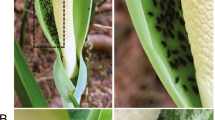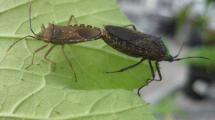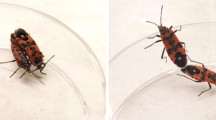Abstract
Mate discrimination could be critical for invasive species that need to locate rare suitable mates and avoid costs associated with misdirected courtships to establish in new environments. Here, we tested whether individuals of two invasive whitefly species in the Bemisia tabaci species complex, commonly known as the B and Q biotypes, could discriminate between potential mates based on their species and sex. Behavioral observations showed that B females were more discriminating than Q females. Males of both species were able to discriminate between mates based on their species and sex, but in general B males discriminated more effectively than Q males. By incorporating these behavioral data into a conceptual model, we show that variation in mating behavior between females of different species was a more significant factor affecting mating than variation between males. These results indicate that mate discrimination could affect interactions between whitefly species and influence a species’ ability to colonize novel environments.





Similar content being viewed by others
References
Andersson MB (1994) Sexual selection. Princeton University Press, Princeton
Arnold SJ, Duvall D (1994) Animal mating systems: a synthesis based on selection theory. Am Nat 143:317–348
Arnqvist G, Rowe L (2005) Sexual conflict. Princeton University Press, Princeton
Bonduriansky R (2001) The evolution of male mate choice in insects: a synthesis of ideas and evidence. Biol Rev 76:305–339
Butler MJ, Stein RA (1985) An analysis of the mechanisms governing species replacements in crayfish. Oecologia 66:168–177
Byrne DN, Bellows TS (1991) Whitefly biology. Annu Rev Entomol 36:431–457
Byrne FJ, Devonshire AL (1996) Biochemical evidence of haplodiploidy in the whitefly Bemisia tabaci. Biochem Genet 34:93–107
Cordts R, Partridge L (1996) Courtship reduces longevity of male Drosophila melanogaster. Anim Behav 52:269–278
Crowder HAR, De Barro PJ, Liu S-S, Showalter AM, Kontsedalov S, Khasdan V, Shargal A, Liu J, Carrière Y (2010a) Mating behaviour, life-history, and adaptation to insecticides determine species exclusion between whiteflies. J Anim Ecol 79:563–570
Crowder DW, Sitvarin MI, Carrière Y (2010b) Behavioral plasticity drives asymmetric reproductive interference between whiteflies. Anim Behav 79:579–587
Dalton R (2006) The Christmas invasion. Nature 443:898–900
De Barro PJ, Bourne A (2010) Ovipositional host choice by an invaded accelerates displacement of its indigenous competitor. Biol Invasions, in press. doi: 10.1007/s10530-010-9691-1
De Barro PJ, Bourne A, Khan SA, Brancatini VAL (2006) Host plant and biotype density interactions—their role in the establishment of the invasive B biotype of Bemisia tabaci. Biol Invasions 8:287–294
Denholm I, Cahill M, Dennehy TJ, Horowitz AR (1998) Challenges with managing insecticide resistance in agricultural pests, exemplified by the whitefly Bemisia tabaci. Phil Trans Roy Soc Lond B 353:1757–1767
Dinsdale A, Cook L, Riginos C, Buckley YM, De Barro P (2010) Refined global analysis of Bemisia tabaci (Hemiptera: Sternorrhyncha: Aleyrodoidea: Aleyrodidae) mitochondrial cytochrome oxidase 1 to identify species level genetic boundaries. Ann Entomol Soc Am 103:196–208
Gröning J, Hochkirch A (2008) Reproductive interference between animal species. Q Rev Biol 83:257–282
Harari AR, Brockmann HJ, Landolt PJ (2000) Intrasexual mounting in the beetle Diaprepes abbreviatus (L.). Proc Roy Soc Lond B 267:2071–2079
Höglund J, Sheldon BC (1998) The cost of reproduction and sexual selection. Oikos 83:478–483
Jennions MD, Petrie M (1997) Variation in mate choice and mating preferences: a review of causes and consequences. Biol Rev 72:283–327
Khasdan V, Levin I, Rosner A, Morin S, Kontsedalov S, Maslenin L, Horowitz AR (2005) DNA markers for identifying biotypes B and Q of Bemisia tabaci (Hemiptera: Aleyrodidae) and studying population dynamics. Bull Entomol Res 95:605–613
Kokko H, Mappes J (2005) Sexual selection when fertilization is not guaranteed. Evolution 59:1876–1885
Kokko H, Brooks R, Jennions MD, Morley J (2003) The evolution of mate choice and mating biases. Proc Roy Soc London B 270:653–664
Liou LW, Price TD (1994) Speciation by reinforcement of premating isolation. Evolution 48:1451–1459
Liu S-S, De Barro PJ, Xu J, Luan J-B, Zang L-S, Ruan Y-M, Wan F-H (2007) Asymmetric mating interactions drive widespread invasion and displacement in a whitefly. Science 318:1769–1772
Martinez-Carillo JL, Brown JK (2007) First report of the Q biotype of Bemisia tabaci in southern Sonora, Mexico. Phytoparasitica 35:282–284
Moya A, Guirao P, Cifuentes D, Beitia F, Cenis JL (2001) Genetic diversity of Iberian populations of Bemisia tabaci (Hemiptera: Aleyrodidae) based on random amplified polymorphic DNA-polymerase chain reaction. Mol Ecol 10:891–897
Nasci RS, Hare SG, Willis FS (1989) Interspecific mating between Louisiana strains of Aedes albopictus and Aedes aegypti in the field and laboratory. J Am Mosq Control 5:416–421
Partridge L, Farquhar M (1981) Sexual activity reduces lifespan of male fruit flies. Nature 294:580–582
Perring TM, Symmes EJ (2006) Courtship behaviour of Bemisia argentifolii (Hemiptera: Aleyrodidae) and whitefly mate recognition. Ann Entomol Soc Am 99:598–606
Reitz SR, Trumble JT (2002) Competitive displacement among insects and arachnids. Annu Rev Entomol 47:435–465
Ribeiro JMC, Spielman A (1986) The satyr effect: a model predicting parapatry and species extinction. Am Nat 128:513–528
Rosell RC, Bedford ID, Frohlich DR, Gill RJ, Brown JK, Markham PG (1997) Analysis of morphological variation in distinct populations of Bemisia tabaci (Homoptera: Aleyrodidae). Ann Entomol Soc Am 90:575–589
SAS Institute (2004) JMP 5.1, Cary, NC
Serrano JM, Castro L, Toro MA, Lόpez-Fanjul C (2000) Inter- and intraspecific sexual discrimination in the flour beetles Tribolium castaneum and Tribolium confusum. Heredity 85:142–146
Sokal RR, Rohlf FJ (1995) Biometry. WH Freeman and Co, New York
Switzer PV, Forsythe PS, Escajeda K, Kruse KC (2004) Effects of environmental and social conditions on homosexual pairing in the Japanese beetle (Popillia japonica Newman). J Insect Behav 17:1–16
Thornhill R, Alcock J (1983) The evolution of insect mating systems. Harvard University Press, Cambridge
Ueda S, Brown JK (2006) First report of the Q biotype of Bemisia tabaci in Japan by mitochondrial cytochrome oxidase I sequence analysis. Phytoparastica 34:405–411
Xu J, De Barro PJ, Liu SS (2010) Reproductive incompatibility among genetic groups of Bemisia tabaci supports the proposition that the whitefly is a cryptic species complex. Bull Entomol Res 100:359–366
Zang L-S, Liu S-S (2007) A comparative study on mating behaviour between the B biotype and a non-B biotype of Bemisia tabaci (Hemiptera: Aleyrodidae) from Zhejiang, China. J Insect Behav 20:157–171
Zhang LP, Zhang YJ, Zhang WJ, Wu QJ, Xu BY, Chu D (2005) Analysis of genetic diversity among different geographical populations and determination of biotypes of Bemisia tabaci in China. J Appl Entomol 129:121–128
Acknowledgements
We thank T. Dennehy for providing whitefly colonies, C. Ellers-Kirk for assistance with colony rearing, D. Byrne, J. Hardin, and M. Asplen for assistance with the experimental design, and A. Rypstra and K. Wrinn for constructive comments. Partial funding was provided by the United States Environmental Protection Agency (STAR Fellowship FP-91648901 to D.W.C.) and the United Stated Department of Agriculture (NRICGP grant 2007-35302-18225 to Y.C.).
Author information
Authors and Affiliations
Corresponding author
Rights and permissions
About this article
Cite this article
Crowder, D.W., Sitvarin, M.I. & Carrière, Y. Mate Discrimination in Invasive Whitefly Species. J Insect Behav 23, 364–380 (2010). https://doi.org/10.1007/s10905-010-9219-7
Revised:
Accepted:
Published:
Issue Date:
DOI: https://doi.org/10.1007/s10905-010-9219-7




